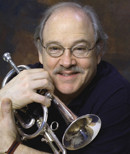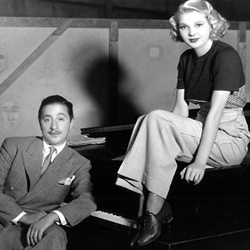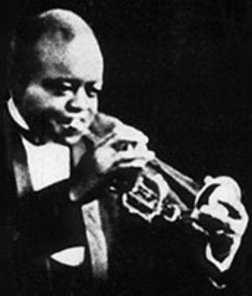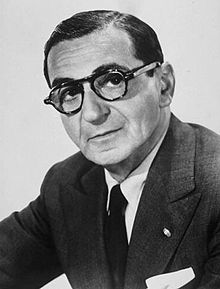
Dinkelspiel Auditorium at Stanford University. Photo courtesy Stanford.
Our show this week was captured live at Dinkelspiel Auditorium on the campus of Stanford University as part of the annual Stanford Jazz Workshop. For over a decade beginning in the early 1990s, The Jim Cullum Jazz Band traveled to California each July for a two-week teaching and performing residency at the renowned jazz workshop. Joining the highly respected teaching faculty—which has included Dizzy Gillespie and Stan Getz—the Cullum band shared its vast knowledge of early jazz, blues, and popular song with a new generation of musicians in a series of lectures, master classes and music lessons, culminating with an annual concert at Dinkelspiel Auditorium.

Bandleader Jim Cullum. Photo courtesy Riverwalk Jazz.
This edition of Riverwalk Jazz captures Jim Cullum and his Band in top form, playing a set drawn from hundreds of tunes frequently performed at The Landing jazz club in San Antonio. The legendary cohesiveness and polish of the band is enabled in part by their weekly schedule of playing together six nights a week—and the stability of band personnel over several decades. In this respect, The Jim Cullum Jazz Band is unique among groups specializing in early 20th century jazz styles.
Introduced in 1930 by Ruth Etting in the Nine-fifteen Revue, "Get Happy" was the first tune to put Harold Arlen on the map of ‘golden-age’ tunesmiths in American music history. Arlen went on to a brilliant songwriting career, creating a vast body of standard tunes performed by jazz artists today, including "Stormy Weather," "That Old Black Magic," "Come Rain or Come Shine," and the score for the MGM movie The Wizard of Oz with its towering hit "Somewhere, Over the Rainbow." Here, The Jim Cullum Jazz Band makes the most of the upbeat and infectious revival meeting theme of Arlen’s “Get Happy.”

Harold Arlen and his wife Anya Taranda. Photo courtesy Wikipedia.
"St. Louis Gal" was a 1923 hit for blues shouter Bessie Smith. The lyric, sung by Topsy Chapman with The Jim Cullum Jazz Band on a previous radio show, is all about ‘man-stealin'’ and ‘jealous rage.’ In this instrumental version, the Band takes it easy and enjoys the slow-drag, blues-drenched feel of it.
Crescent City cornetist and jazz band pioneer King Oliver made the original Columbia recording of his composition “New Orleans Stomp” in 1923 in Chicago at a time when both he and his band were at their peak. In the early 20s, Oliver led the hottest New Orleans-style jazz band on the Windy City's South Side, with the young Louis Armstrong on second cornet. As later events would prove, Oliver’s band provided the key influence, inspiration and model for swinging and stomping jazz in Chicago and beyond. The Jim Cullum Jazz Band gives it their all with a rendition of “New Orleans Stomp” faithful to the concept of the original.

Joe King Oliver. Photo courtesy last.fm.
In 1911 "Alexander's Ragtime Band" skyrocketed songwriter Irving Berlin to fame. It was his first mega-hit, selling millions of copies of sheet music and ushering in a new era in popular music. Author Phillip Furia writes that the international success of "Alexander's Ragtime Band" gave ragtime "new life and sparked a national dance craze." Recordings by a variety of artists from Louis Armstrong to Ray Charles kept “Alexander’s Ragtime Band” on national charts for five decades. The chorus of Berlin’s upbeat tune gives The Jim Cullum Jazz Band a chance to showcase their style of improvised ensemble playing.

Irving Berlin. Photo courtesy Wikipedia.
"Deep Night" from 1929 was co-written by the crooner pop star Rudy Vallée, one of the first vocal artists to rely on the new electric microphone more than sheer voice projection. Vallée’s trombone-like vocal phrasing on his recording of “Deep Night” is said to have influenced later crooners like Bing Crosby and Frank Sinatra to model their vocal styles on jazz instruments. The tune is a favorite of The Jim Cullum Jazz Band.
"Enchilada Man" is an original up-tempo multi-strain march composed by bandleader Jim Cullum. The title, Jim’s homage to local San Antonio cuisine, might also refer to the spicy heat of the cornetist’s stellar performance of this piece.
"My Gal Sal" (also known as "Frivolous Sal") was a 1905 melodramatic tearjerker, or so-called parlor song, composed by Paul Dresser. Dresser was among the first successful songwriters in New York's Tin Pan Alley music publishing district. Hot jazz bands of the 1920s, such as Red Nichols and His Five Pennies, were fond of taking these old, familiar melodies and swinging them in 4/4 at a brisk clip, as does The Jim Cullum Jazz Band in this version.
Another parlor song transformed by the band's "hot rhythm treatment" on this week’s radio show is "Bedelia (I Want to Steal You, Bedelia, I Love You So)” —a #1 hit in early 1904.
Photo credit for Home Page: Jim Cullum by Nick Balkin. Photo courtesy Riverwalk Jazz
Text based on Riverwalk Jazz script by Margaret Moos Pick © 1997

